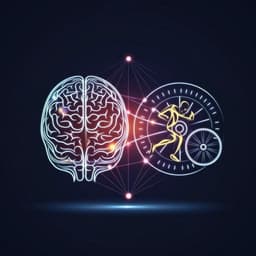
Medicine and Health
Physical exercise restores adult neurogenesis deficits induced by simulated microgravity
A. Gros, F. M. Furlan, et al.
This groundbreaking study by Alexandra Gros and colleagues explores how simulated microgravity affects neurogenesis in rats, revealing that physical exercise can counteract its impacts on brain cell proliferation and survival. The results suggest new insights into space research and its implications for human health.
~3 min • Beginner • English
Introduction
Long-duration space missions expose astronauts to multiple stressors including microgravity, radiation, isolation, and circadian disruption, leading to reported neurocognitive changes and brain structural and functional alterations. Understanding how reduced gravity affects neuroplasticity is important for astronaut health. Rodent hindlimb unloading (HU) models simulate microgravity on Earth and replicate human physiological adaptations. Prior studies indicate HU can alter neurotransmission, neuronal morphology, electrophysiology, and gene/protein expression in cortex and hippocampus, potentially underpinning cognitive deficits. Adult neurogenesis in the dentate gyrus (DG) and subventricular zone/olfactory bulb (SVZ/OB) supports learning and memory. While irradiation and social isolation are known to affect neurogenesis, the specific impact of microgravity on proliferation, survival, and maturation of adult-born neurons remains understudied. This study tests whether SMG alters distinct stages of adult neurogenesis in rats and evaluates physical exercise as a countermeasure.
Literature Review
Previous HU studies reported decreased proliferation in SVZ and DG after approximately two weeks of unloading, with in vitro SVZ-derived neural stem cells from HU mice showing reduced proliferation, altered cell cycle, and incomplete differentiation. Microgravity-related changes in neurotransmission, monoamine distribution, hippocampal neuronal morphology/electrophysiology, and hippocampal/cortical gene and protein expression have been documented and linked to cognitive deficits. Irradiation robustly impairs adult neurogenesis in SVZ and DG; social isolation or impoverished environments also modulate neurogenesis. Shorter HU exposures (e.g., 3 days) did not reduce hippocampal proliferation, suggesting time-dependent effects. Spaceflight studies in mice showed no change in OB newborn neuron density after 13 days, whereas head-down bed rest in primates impaired DG survival, potentially confounded by restraint stress. Exercise is a well-established enhancer of adult neurogenesis and is routinely used by astronauts to mitigate microgravity’s systemic effects.
Methodology
Animals: Adult male Long-Evans rats (n=124) were used under approved ethical protocols. Rats were group-housed initially, then acclimated and individually housed.
Simulated microgravity (HU): Hindlimb unloading employed a tail-suspension system allowing 360° forelimb movement with 40–45° head-down tilt. Durations: 6 h, 24 h, 7 days, or 21 days.
Experimental design: Adult neurogenesis cohorts (n=97) and gene expression cohorts (n=24). For proliferation: single EdU (200 mg/kg) and sacrifice at 6 h or 24 h; or BrdU (200 mg/kg) injected 24 h before sacrifice after 7 or 21 days of SMG/CTL to tag cells in S-phase near endpoint. For survival: two EdU injections 6 h apart, then sacrifice at 7 or 21 days during CTL or SMG. Some animals received both EdU and BrdU to reduce animal numbers.
Exercise protocol: Separate groups underwent forced treadmill running 30 min/day for 3 weeks (2 weeks before HU + 1 week during HU). Week 1 speed 25 cm/s; weeks 2–3 at 30 cm/s; speeds/duration adjusted for some animals to ensure welfare. Exercise was used in 7-day SMG condition (adult neurogenesis and gene expression arms).
Physiological monitoring: Daily body weight, food/water intake, temperature; glycemia at baseline and selected time points; plasma corticosterone by ELISA before perfusion. Soleus (hindlimb) and ECRL (forelimb) muscles were weighed to validate HU effects and assess exercise impact.
Histology and immunostaining: Brains were perfusion-fixed, sectioned (40 µm). EdU revealed by Click-iT. BrdU immunolabeled after DNA denaturation. Additional markers: GFAP, Sox2 (progenitor/stem cell markers), DCX (immature neurons), NeuN (mature neurons). Imaging by fluorescence/confocal systems.
Cell quantification: EdU+/BrdU+ densities measured in DG (dorsal hippocampus), SVZ, and OB on serial sections, with standardized surface areas. Automated detection used for SVZ/OB; DG counted via microscopy. Percentages of EdU+ cells co-expressing DCX/NeuN quantified.
Gene expression: RT-qPCR using a pre-designed neurogenesis gene panel (82 genes), normalized to Hprt1; fold-change threshold 2.5 for calling changes. Bulk RNA-seq on hippocampal RNA (polyA selection; Illumina NextSeq 2000 PE 2x100 bp; ≥30M reads/sample). QC with fastp; alignment with STAR to Rnor_6.0; DEGs via DESeq2; visualization via volcano plots. Analyses compared SMG vs CTL at 7 and 21 days; duration effects; and exercise effects (CTL Exe and SMG Exe).
Statistics: Normality tests; unpaired t-tests/Mann-Whitney; one-, two-, or three-way ANOVA with appropriate post hocs (Bonferroni, Tukey, Dunnett); repeated measures where applicable; significance p<0.05.
Key Findings
- HU validation: 7 days SMG decreased soleus muscle weight (t=6.57, p<0.001), no effect on ECRL (t=0.07, p=0.95).
- Stress/physiology: EdU injections elevated corticosterone at 6 h in both CTL and SMG (no group difference overall) with time-dependent decrease in CTL but not SMG, indicating potentiated injection-related stress under SMG. Food/water intake changes post-injection were transient; temperature and glycemia remained within physiological ranges.
- Body weight: After EdU injections, SMG rats showed delayed return to baseline weight (day 13) and later significant gain vs CTL (significant CTL–SMG difference from day 4; mixed ANOVA SMG effect F(1,42)=60.91, p<0.001). Without EdU (gene expression cohort), SMG rats lost weight and recovered by day 8; CTL gained weight steadily.
- Proliferation: No effect of 6 h or 24 h SMG on EdU+ cell density in DG or SVZ. After 7 days SMG, BrdU+ density decreased in DG (two-way ANOVA SMG effect F(1,20)=5.76, p=0.026; Bonferroni p=0.013); no effect at 21 days; SVZ unaffected at both times. GFAP/Sox2 expression in progenitors not altered by short SMG.
- Survival: EdU+ cell density decreased after 7 days SMG in DG and SVZ (DG interaction F(1,24)=5.18, p=0.032; Bonferroni p=0.017; SVZ SMG effect F(1,23)=6.4, p=0.019; Bonferroni p=0.003). No differences at 21 days. OB survival unaffected. Maturation (DCX↓ over time and NeuN↑ over time) proceeded normally; SMG did not change DCX/NeuN proportions.
- Exercise effects (7-day SMG paradigm): Exercise increased soleus weight (exercise effect F(1,12)=18.45, p=0.001). Exercise accelerated post-EdU weight recovery in CTL (by ~4 days) but not in SMG over 7 days. Exercise increased EdU+ survival in CTL DG and OB. Critically, in SMG rats exercise restored EdU+ densities in DG (p=0.038) and SVZ (p=0.028) to CTL levels; no rescue in OB. Exercise reduced %DCX in SVZ (exercise effect F(1,58)=16.94, p<0.001) and slightly in OB under SMG; NeuN unaffected.
- Gene expression (RT-qPCR): After 7 days SMG, 25 neurogenesis-related genes were downregulated (≥2.5-fold), suggesting global impairment; after 21 days SMG, 3 genes were upregulated (Alk, Cxcl1, Neurog1), indicating potential compensatory responses. Some (Cxcl1, Neurog1) showed opposite regulation between 7 and 21 days.
- Gene expression (RNA-seq, GO: neurogenesis): SMG vs CTL: 7 days altered 4 genes (Ascl1, Celsr1, Prdm8 up; Xrcc5 down); 21 days altered 11 genes (e.g., Adgrv1 down; Nav1/Nav2 up; Pcsk1 up; Wnt1 up). Five genes were affected at both durations (Fabp7, Mesp1, Nfix, Smarca4, Tubala). Duration within SMG increased several genes (e.g., Prdm12, Grin2a, Nfia, Psen1). CTL duration also affected some genes, indicating isolation/time effects on some transcripts.
- Exercise and gene expression: Exercise downregulated many neurogenesis-related genes in both CTL (27 genes) and SMG (39 genes) by RT-qPCR; patterns differed from SMG effects and generally did not reverse SMG-regulated genes. RNA-seq showed Grin2a and Dagla increased with exercise in both CTL and SMG; Ascl1 changes under SMG were modulated by exercise in RT-qPCR dataset.
Discussion
The study demonstrates that simulated microgravity transiently impairs adult neurogenesis in rats: proliferation in the DG and short-term survival in DG and SVZ decreased after 7 days of HU, while effects were no longer evident after 21 days. Maturation of newborn neurons proceeded normally, suggesting that early stages are particularly sensitive, followed by physiological adaptation. These transient cellular effects may contribute to cognitive vulnerabilities experienced during early phases of exposure to reduced gravity, particularly for hippocampal-dependent memory. Physical exercise, implemented as a prehabilitation and concurrent countermeasure, restored newborn cell survival in DG and SVZ under SMG to control levels and enhanced survival in control animals, supporting exercise as an effective mitigation strategy. Transcriptomic analyses indicate that SMG modulates neurogenesis-related pathways in a time-dependent manner: broad downregulation at 7 days and upregulation of select genes at 21 days, consistent with an adaptive response. Exercise altered gene expression patterns through partly distinct pathways and did not simply reverse SMG-driven transcriptomic changes, suggesting complementary mechanisms. These findings underscore a sensitive period during initial exposure to SMG and the value of exercise countermeasures to preserve neurogenic plasticity.
Conclusion
Simulated microgravity caused a transient impairment of adult neurogenesis in rats, reducing DG proliferation and short-term survival in DG and SVZ after 7 days but not after 21 days. A three-week treadmill exercise regimen (2 weeks pre-exposure plus 1 week during SMG) restored newborn cell survival in DG and SVZ under SMG and enhanced survival in controls, highlighting exercise as a practical countermeasure. Gene expression analyses revealed time-dependent modulation of neurogenesis-related genes under SMG and distinct exercise-driven transcriptional effects, consistent with adaptation and compensatory mechanisms. Future work should: (1) link these cellular changes to cognitive outcomes across hippocampal- and olfaction-dependent tasks; (2) employ single-cell and spatial transcriptomics to resolve cell-type–specific responses; (3) examine combined spaceflight stressors (e.g., radiation, hypomagnetic field), sex differences, and optimize exercise modality, intensity, and timing relative to SMG exposure; and (4) broaden molecular profiling beyond neurogenesis to learning and memory pathways.
Limitations
- Transcriptional profiling emphasized neurogenesis-related genes with bulk RNA-seq; single-cell resolution and whole-transcriptome focus on learning/memory pathways were not performed.
- Behavioral/cognitive functions were not assessed, limiting direct linkage between neurogenesis changes and performance.
- Some comparisons had small group sizes, potentially limiting statistical power (e.g., 21-day cohorts).
- Only male rats were studied; sex-specific responses were not addressed.
- Environmental stressors beyond SMG (e.g., radiation) were not combined, reducing ecological validity relative to spaceflight.
- Isolation and injection-related stress may contribute to some physiological changes despite controls; time in isolation affected some gene expression independently of SMG.
Related Publications
Explore these studies to deepen your understanding of the subject.







